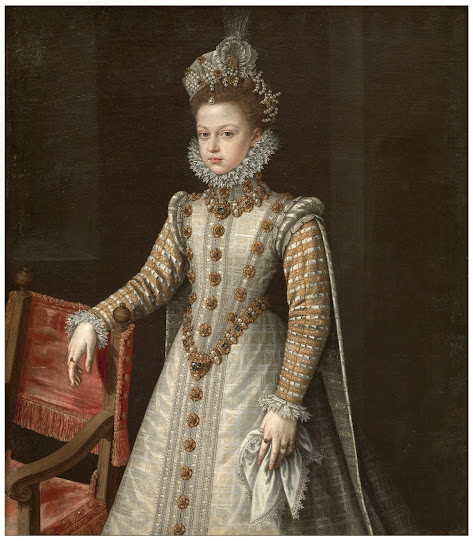I choosed Las Meninas, de Velazquez. Being Spanish, I simply could not stop talking about it. I have visited the Prado Museum many times and spent thousands of minutes looking at it.
The painting is a portrait of princess Margarita of Austria, but many more persons are portrayed than that. Margarita occupies the front plane, illuminated by a direct she stands out with her white dress and perfect posture. Surrounding her are Las Meninas, who are her personal maids, and what gives this work its title. Unfortunately, it is neither signed nor dated, so our best guess is to assume how old the Princess looks, knowing she was born in 1651.
To the left, we can see a giant canvas painted by Velazquez himself. He decided to add a discrete self-portrait in the shadow of the canvas. Behind him, we find a mirror, and the reflection reveals no other than Felipe IV and the Mariana of Austria, the king and the queen. This has never been done before, portraying the King in a bit of detail hidden in the scene? Velazquez wanted to incorporate them as caring parental figures for Margarita, looking out for her and watching. Obviously, this portrait had been commissioned directly by the king since Velazquez was the royal painter of the court. His job was to create images and scenes that would be used as propaganda for the royal family as a Catholic Family. When he painted Las Meninas, he was so close to the king that he knew what was happening on the court and with the royal family.
A couple more characters appear in the scene; the woman in widow's clothes is the responsibility of the Meninas and takes care of them. We do not know who she is talking to, but probably a janitor. Finally, the right corner is cheerfully populated by two "dwarfs" that entertained the princess with jokes and tricks. One of them is trying to bother the dog as a little prank. All these ads to the happy family narrative the royal family was trying to project.
The figures closer to the audience have been painted with loose strokes and little highlights. The definition of the image decreases as we go deeper into the scene, bringing the sense of space and atmotsfera above the figures. Velazquez painted this complex interior, incorporating the room's ceiling. The light coming from the side windows allows the separation of the scene alternating between light and shadow planes. A resource that adds to the sense of depth. This is clearly seen at the end of the room, where the door frame is illuminated.
The function that the painting served was to portray a familiar scene that was warm and intimate. Velazquez's most famous painting; was a commentary on the baroque portraits and a painting over a painting.
Here is another Infanta for comparison, but this time from the renascence. She is Clara Eugenia, daughter of Philip II. She was painted by Alonso Sanchez Coello in 1577.
She is also dressed up in white, like Margarita. Her sleeves have fine gold details and lots of lace. We can see an incredible amount of pearls on her head, and some feathers accompany them and gems. The handkerchief that she holds in her hand is a detail often found in feminine portraits, and her hand resting on the chair denotes her elevated position on the court. She is about to turn twelve, the minimum age to get married.
In comparison with margarita, She is portrayed to look older and more mature. No one is playing around with her or assisting. She is, by herself, a proud and stoic Infanta. One quickly forgets she is still a child.
The light also plays a role in this portrait, but rather than creating a welcoming and warm atmosphere, the light is cast right on her, like a spotlight. The background is barely illuminated and provides little context to the scene. In comparison, Las Meninas is cold and intimidating.
Velazquez was a master of portraits, not only by the atmosphere but also because he could captivate the personality and minds of the people who painted.
References:
Arte, La Cámara del. “Las Meninas - La Cámara Del Arte.” La Cámara Del Arte - El Sitio Del Arte y La Cultura, 22 Dec. 2021, https://lacamaradelarte.com/obra/las-meninas/.
“La Infanta Isabel Clara Eugenia - Colección.” Colección - Museo Nacional Del Prado, https://www.museodelprado.es/coleccion/obra-de-arte/la-infanta-isabel-clara-eugenia/ea291441-e729-438c-90a1-3ab1f65b7487.
“Las Meninas - Colección.” Colección - Museo Nacional Del Prado, https://www.museodelprado.es/coleccion/obra-de-arte/las-meninas/9fdc7800-9ade-48b0-ab8b-edee94ea877f.
Pérez Javier Portús, and Velázquez Diego. Velázquez: Guía. Museo Del Prado, 1999.


Comments
Post a Comment